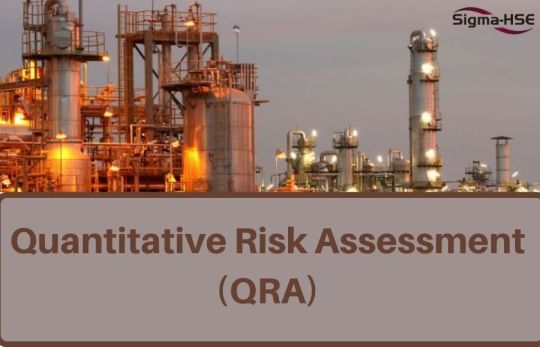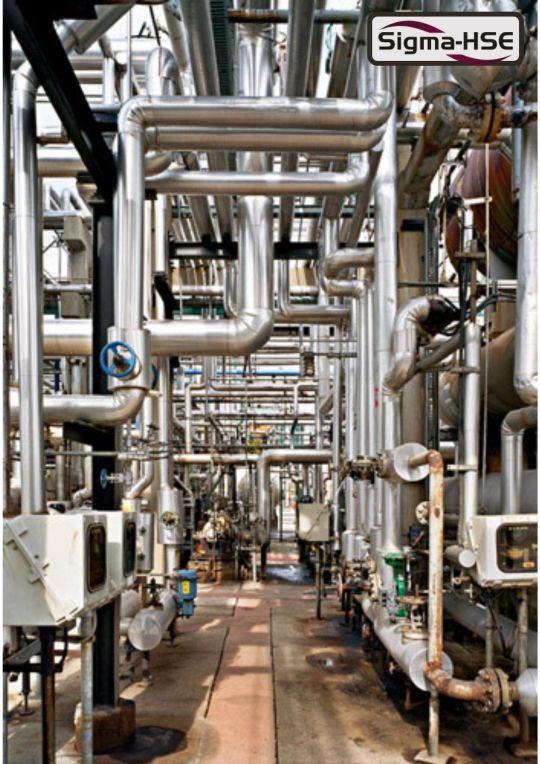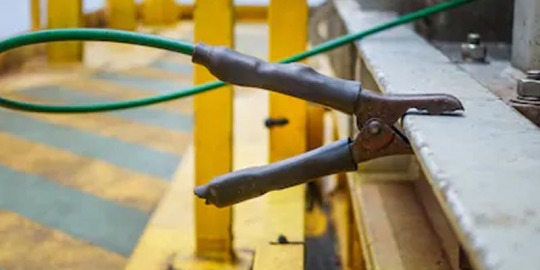Text
Air over layer - Gas & Vapour Testing | Sigma-HSE
The air over layer test is conducted to establish the onset temperature of exothermic activity of thin layers of material when exposed to elevated atmospheric temperatures. It replicates thin layer (up to 15 mm) deposits in any drying situation i.e. drier walls and roof where hot air rushes over its surface.

Using a small tray test cell, the sample is placed inside the cell and thermocouples placed into the material at three locations. This assembly is placed into a digitally controlled, horizontal, laboratory tube oven with controlled heated air supply and either of the following tests performed using a data acquisition system to monitor, detect and record any exothermic activity.

SCREENING TEST
The environmental temperature is digitally ramped from ambient conditions up to 400°C at 0.5°C.min-1. This test configuration is used for estimating exothermic activity onset temperature.
ISOTHERMAL TEST
The loaded test cell is placed into a heated oven, set to a specified temperature for a duration of 24hr. The temperature selected can either be based on working or proposed process conditions (plus a factor of safety) or full determination can be undertaken, conducting several isothermal tests to establish a definitive ignition temperature.
Benefits
Not only is the air over layer test a necessity in evaluating whether current or proposed drying and process temperatures are safe, it can also confirm the possibility of using a higher temperatures to increase productivity.
0 notes
Text
Hazardous Area Classification
In the industrial plant where flammable liquids, gases and vapours, combustible dust or fibres and flyings are handled, processed, or otherwise generated, there can be a risk of fire or explosion. In order to have a fire or an explosion, fire triangle or explosion pentagon must be met. There must be fuel present, the fuel must be mixed with an oxidant (typically the oxygen in the air) in the appropriate ratio, and an ignition source of enough intensity must be present.

Hazardous area classification (HAC) identifies the areas in a plant where an explosive or flammable atmosphere may be present under foreseeable circumstances.

The procedure is used to identify the extent and duration that flammable atmospheres can be present in normal and conceivable abnormal conditions. The aim is to identify whether flammable atmospheres can form in a process equipment and process operation when the plant is in use and to identify whether the flammable atmosphere can be present:
a) Continously
b) During normal operation of the process, or
c) Only during abnormal or mal-operation conditions and then only for a short time.
This assessment must cover the release of flammable materials, the nature of the material, ventilation, and frequency of release and the potential duration of such an event.Originally HAC was used to enable process companies to make the correct choice of electrical equipment to prevent electrical ignition of flammable atmospheres. Now HAC is being applied in wider risk assessment work and to counter a range of ignition sources, such as electrostatic sparks, and flammable substances, such as solvent vapours, gases or mists and dust clouds. For this reason, HAC is needed not only in chemical plants but in a variety of other industries including food, power, wood, etc.At Sigma-HSE (India), our hazardous area classification consulting services are designed as per the customer needs to follow IEC, IS/IEC, NFPA and other standards. Our team members are knowledgeable about classification, electrical equipment and wiring, applicable standards and codes, chemicals used, plant safety, ventilation assessment, and more. When you work with us, we ensure safe and consistent classification via the application of sound engineering judgment and the careful evaluation of all data in accordance with established techniques.
0 notes
Text
Emergency Response and Disaster Management Planning
In today’s global risk environment, an emergency preparedness program and capability are not optional for an organization. They are imperatives at the heart of compliance and good corporate governance. Establishing an emergency response and disaster management capability helps the company prepare for, respond to, and recover from adverse incidents. One need to be ready to respond in a coordinated, timely, and effective manner to natural, technological, or man-made disasters.
A well written emergency response & disaster management plan and proper training help to ensure that those charged with responding will know their responsibilities and what they are expected to do during an emergency situation. Scope of ERDMP involves the following:
Development of an Emergency Preparedness Plan to control and avert any disaster scenario that could be anticipated and the consequence of human and property damage. We utilize the latest applicable guidelines and rules such as PNGRB, MSIHC, CAEPPR, NDMA, etc.
Identification of major hazards and emergency categorization by taking inputs from existing QRA report.
Development of Emergency Management Structure (covering following key areas)
Emergency Facilities Management including designating emergency control centre, assembly points/ shelter-in-place, emergency escape routes, emergency communication, medical facilities, etc.
Incident Management System including emergency notification and declaration, control of emergency, role of key personnel such as site controller, incident controller, team leader and members, etc.
Procedure to handle specialized emergencies
At Sigma-HSE, we have experience in developing ERDMPs for the oil & gas, chemical, pharmaceutical, FMCG, metallurgical, powder processing, paint, textile among other sectors. We help companies by supporting the entire process of preparation, implementation and Training on Emergency Response/Preparedness and Disaster Management Plan (ERDMP).


0 notes
Text
Incident Investigation
When an incident (particularly related to process safety) occurs, a thorough third-party investigation is required. The aim of these investigations is to enable a company to establish the root causes of the incident (including human factors) and to avoid recurrence of the incident. The investigation also helps in identification of management issues (if present) that may be having an effect on process safety. These issues could include communication, culture or competency.
An incident investigation is aimed to:
· Identify the root cause of the accident
· Analyze the escalation factors that increased the extent of loss
· Provide recommendations that prevent the recurrence of such incidents in future
Many of the root causes of an incident are revealed when a systematic analysis of the human factors involved in the incident are identified. Often due to the system constraints, inhouse team have not been identified the systemic root causes and that’s where third party incident investigation is necessary.
Our experts have experience in carrying out investigation in the chemical, pharmaceutical, oil & gas, FMCG, metallurgical, powder processing, paint and agricultural industries among other sectors. We have investigated fires/ explosions, near miss incidents involving:
· Gases, vapors, aerosols or mists, dusts, powders, and solid materials
· Runaway reactions
· Electrostatic discharges, and the consequences of such discharges
· Ignition source identification
· Unknown hazardous properties of materials
We, at Sigma-HSE, understand the confidentiality of chemical plant specific information and will hold all information, findings, observations, reports, etc. in strictest confidence.


0 notes
Text
Quantitative Risk Assessment (QRA)

Understanding the risk is important for rational and cost-effective decision-making. QRA (Quantitative Risk Assessment) has been proven as a valuable management tool in assessing the overall safety performance of any facility manufacturing, storing or handling hazardous materials. The potential for toxic and/or flammable materials to be accidently released into atmosphere exists at many industrial facilities. Loss of containment (LOC) events can occur very suddenly and unexpectedly, putting employees and offsite population at a risk of injury or death, and the surrounding environment at risk of significant damage or contamination.
0 notes
Text
Hazard and Operability (HAZOP)

HAZOP is a systematic team-based Process Hazard Analysis (PHA) technique. It is used to identify & analyze the consequences & risks arising from possible deviations from the design and operational intent of a process. HAZOP can be used for continuous or batch processes. Also, it can be used during the design stages of a new process or project, for major process modifications, and for periodic review of existing operations. can be adopted to evaluate written procedures.
0 notes
Audio
For the process industry to be successful; it has become essential to identify the hazards, to assess the associated risks and to bring the risks to a tolerable level. Hazard Identification and Risk Analysis (HIRA) is a collective term that encompasses all activities involved in identifying hazards and evaluating risk at facilities, throughout their life cycle, to make certain that risks to employees, the public, or the environment are consistently controlled within the organization’s risk tolerance. Hazard identification and Risk Assessment (HIRA) is a continual process and is carried out to identify whatever could cause injury, damage & ill-health arising out of various routine & non-routine activities and processes.
0 notes
Audio
Non-electrical equipment is commonly used in the handling and processing of flammable liquids, gases and powders in process industries. Typical equipment includes fans, rotary airlocks, pumps, reactor agitators, screw conveyors, bucket elevators, etc. Such equipment items can generate sources of ignition for flammable atmospheres. Hazardous Area Classification traditionally only addresses the ignition hazard of electrical equipment and is used to manage selection and installation methods of electrical devices. However, mechanical equipment as mentioned above can cause frictional heat or frictional sparks during routine operation or due to equipment-upset conditions. To identify and to eliminate or to control these types of ignition sources, an analysis method that is described as a “Mechanical Equipment Ignition Risk Assessment” (MEIRA) can be used which is also called as Non-electrical Equipment Ignition Risk Assessment (NEIRA).
#sigma#Electrostatic Hazard Assessment#Non-electrical equipment#neira#Non-electrical Equipment Ignition Risk Assessment
0 notes
Text
Electrostatic Hazard Assessment | Sigma-HSE

Static electricity may cause nuisance or damage and it may represent a fire or explosion hazard when flammable gases, liquids and powders are handled. Often an electrostatic ignition hazard arises when the electrostatic charge generated in a process is allowed to accumulate to levels sufficient to give rise to electrostatic discharges.
Thus, the first step in an electrostatic hazard assessment is identifying where in the process electrostatic charge can be generated and accumulated. Next, if the generation and accumulation of charge cannot be controlled, the types of electrostatic discharges that can arise must be identified. Lastly, in order to verify that a hazard exists, the effective energy of these discharges must be determined and compared to the minimum ignition energy (MIE) of the prevailing flammable atmosphere.
0 notes
Text
Dust Hazard Assessment - combustible dust | Sigma-HSE

Combustible dust is a finely divided particulate solid that presents a flash-fire hazard or explosion hazard when suspended in air, or another oxidizing medium.
Combustible Dust Hazards are a concern for almost every industry and plant - in particular, pharmaceutical, food/ agriculture, metal, cosmetic, chemical manufacturing, paint and pigment, wood, plastic, and polymer. Many facilities manufacture and/ or handle materials in the form of powders and some facilities generate powders through handling and processing solid materials. Such facilities may be subject to combustible dust hazards.
0 notes
Text
Introducing POWDER TESTING LAB in Delhi (India)

Sigma-HSE launch of powder testing laboratory in Delhi, India. The Powder Testing Laboratory will have the following capabilities:
Dust Combustibility (Go/ No Go Test) ·
Minimum Ignition Energy (MIE) ·
Minimum Ignition Temperature (MIT) ·
Layer Ignition Temperature (LIT) ·
Burning Behaviour ·
Powder Volume Resistivity
*Other testing facilities are available at our lab located in Winchester UK.
Contact us for further information on 011-43565446 and [email protected]
http://www.sigma-hse.co.in/
#sigma#powder testing lab#dust combustability#minimum ignition temperature#layer ignition temperature#burning behaviour#powder volume resistivity
1 note
·
View note